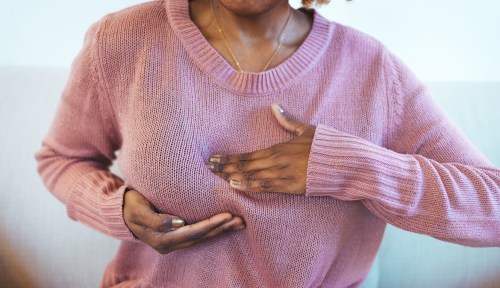Our editors independently select these products. Making a purchase through our links may earn Well+Good a commission
Why You Sometimes Feel *Sad* When Your Nipples Are Touched—Plus What to Do About It
Despite little research, many women report feeling sad when their nipples are touched. Here's what we know about sad nipple syndrome.

Peaked and puckered, rosy and ruched, sensitive and sore. These are the words most commonly used to describe different nipple sensations. But over the last few years, throngs of people have taken to TikTok and Reddit specifically to describe their nipples as sad. Indeed, folks of all ages are singing the breast blues online, sharing how a nipple graze, caress, and kiss can all occasionally evoke feelings of deep despair. Turns out, there’s a name for this: sad nipple syndrome.
Experts in This Article
queer sex therapist and director of The Gender &
Michelle Forcier, MD, MPH, is a professor of pediatrics and assistant dean of admissions at The Warren Alpert Medical School of Brown University. She specializes in sexual health care and is also a staff clinician at FOLX Health.
board-certified in OB/GYN in Chandler, AZ and founder of the leading HPV information site HPV HUB
“Sad nipple syndrome describes when someone experiences intense, usually negative emotion when their nipples are touched,” explains Jesse Kahn, LCSW, CST, a queer sex therapist and director of The Gender & Sexuality Therapy Center in New York City. The emotions associated with sad nipple syndrome can range from sadness to depression, irritation to anger, embarrassment to shame, they say. And almost any kind of touch can trigger the wash of emotion. “It can result from physical touch from one’s partner or one’s self, during breastfeeding, or in response to temperature change, or even from the wind blowing or clothing touching one’s nipples.”
If you have questions about why this happens and what to do about it, read on. Ahead, women’s and mental healthcare experts answer all your questions about sad nipple syndrome.
What is sad nipple syndrome, exactly?
“Sad nipple syndrome” is a phenomenon that occurs when someone experiences pangs of intense negative emotions while or after their nipples are touched, says Khan. The exact negative emotion(s) associated with nipple play or other touch vary from person to person. Some people, including software engineer and lifestyle influencer Thaovy Van, describe feeling an uncontrollable sense of sadness. Others report feeling guilty or ashamed, while others express feelings of loneliness, homesickness, or nostalgia.
Meanwhile, former Well+Good editor and writer Amelia McBride shares, “Ever since I can remember, I’ve experienced strange, random bouts of sadness, anxiety, and shame when touching them,” she says. “It kind of feels like a mix of deep dread, guilt, and anxiety á la the common nightmare of being naked in public, or getting called to the principal’s office in grade school.” Notably, not all people experience sad nipple syndrome in response to the same stimuli. For some, the feeling comes about randomly and suddenly and can be brought on by nonsexual nipple contact, says Kahn. For others, it’s primarily nipple play in a sexual setting that sparks feelings of unease.
What causes sad nipple syndrome?
There has yet to be any medical research conducted about why and when sad nipple syndrome occurs, says Michelle Forcier MD, MPH, FAAP, a gender-affirming clinician with FOLX, an online health provider. Sadly, that is due in part because research surrounding women’s sexual and reproductive well-being is vastly under-studied and underfunded due to sexism. Did you know that the National Institutes of Health didn’t start encouraging scientists to include women in their research until 1986? Experts, however, do have some hypotheses about what could spur this mysterious condition. Some of these potential causes of sad nipple syndrome ahead.
“Very sensitive nipples have endorphins that release when touched.” —Monte R. Swarup, MD, a board-certified OB/GYN and founder of HPD Rx
1. Dysphoric milk ejection reflex (D-MER)
If your breasts are currently doubling as a bottle, you might have Dysphoric Milk Ejection Reflex12 (or D-MER), according to Monte R. Swarup, MD, a board-certified OB/GYN and founder of HPD Rx. A medical condition that affects an estimated nine percent 1of women when breastfeeding, people with D-MER report similar feelings of sadness that are shared amongst non-lactating people with sad nipple syndrome, he says.
For those with D-EMR, the emotional drop usually occurs right before milk is released, usually while breastfeeding or pumping, according to a study published in the International Breastfeeding Journal. When the breast releases milk, the brain experiences an abrupt drop in dopamine, which is known colloquially as the happiness hormone. The result is dopamine deficit for the new parent, which reports say can lead to feelings that range in severity from “wistfulness” to “self-loathing.”
While D-EMR-related feelings of sadness typically last for only a few minutes, the sensation can linger long after breast-feeding has commenced, due to generalized postpartum feelings. There is a “general disturbance of dopamine, oxytocin, and other hormones [during the postpartum period], which results in symptoms that include feelings of hopelessness, anxiety, and or depression,” says Dr. Forcier.
2. General nipple sensitivity
Obviously a diagnosis of D-MER can help explain a new mother’s dysphoria while breastfeeding, it fails to explain the nipple dysphoria felt by those who have never lactated. Without the physiological trigger of milk release, as stated above, how, then, are non-mothers experiencing comparable levels of emotional discomfort? Great question. Well, releasing milk isn’t the only thing that can cause chemical changes. “Very sensitive nipples have endorphins that release when touched,” which could be causing the feel-bad sensations in individuals who report sad nipple syndrome, according to Dr. Swarup.
Indeed, nipple stimulation has been proven3 to result in the secretion of oxytocin, which has been linked with increased survival emotions like fear and anxiety. Here, the theoretical chain of events is that the touch stimulates oxytocin release, which causes the intense wave of emotion sad nipple sufferers experience on contact.
3. Menstrual cycle
Sore and tender nipples are common pre-menstruation symptoms. (Medically this is known as cyclical breast pain). The culprit4 of the sensation sensitivity? Hormones. The estrogen fluctuations are thought to stimulate the breast tissue in such a way that the nipples become sensitive to the touch. Now, here’s where the sadness part comes in: Low mood is a common part of PMS, too. As such, it is possible that a pre-menstruation individual isn’t experiencing sad nipple syndrome, but rather that they are sad and their nipples just so happen to be receiving touch. If you notice an increase in feelings of depression—or any other debilitating symptoms—surrounding your period, talk to your gynecologist. They’ll be able to suggest treatment, as well as determine whether or not premenstrual dysphoric disorder (PMDD) is an underlying cause.
4. Gender dysphoria
Sad nipple syndrome and gender dysphoria are different, says Kahn, but both can lead to feelings of sadness. The difference? When an individual has sad nipple syndrome, it’s tied to touch, not to their identity or sense of self. Gender dysphoria, on the other hand, describes a disconnect between one’s sex assigned at birth and one’s gender. “It’s about a deep discomfort in connection to one’s identity and body,” they say.
Nipple stimulation is one of the things that could trigger gender dysphoria—for instance, if a person has a non-flat chest and wants one. However, several other touches, thoughts, or experiences (i.e. being misgendered, getting called your dead name, seeing photos of yourself) can trigger those distressing feelings, too, explains. All in all, while SND and GD aren’t inherently linked “they can look and feel pretty similar to the person experiencing the distress,” says Kahn.

How do you fix sad nipple syndrome?
At present, there is no official treatment protocol for sad nipple syndrome. Mainly, that’s because more scientific evidence needs to be collected to determine if sad nipple syndrome is hormonal, psychological, physiological, or potentially, a mix of all three, says Dr. Swarup. But don’t despair. There are a number of different steps you can take to reduce the impact sad nipple syndrome has on your life in and out of the bedroom.
1. Consult your healthcare provider
Given that the underlying cause(s) of nipple syndrome will vary from person to person, based on a number of factors such as pregnancy and lactation history, hormonal make-up, religious and spiritual beliefs, previous sexual or emotional trauma, nerve sensitivity and nipple variations, and more, your first step in treatment should be to talk to a healthcare provider, says Sherry A. Ross, MD, FACOG, a board-certified obstetrics-gynecologist at Providence Saint John’s Health Center in Santa Monica, California, and the author of She-ology and The She-quel. “Consulting with a psychologist and/or obstetrician/gynecologist will allow you to gain insight into what personalized treatment options might work for you,” she says.
2. Keep track of your triggers
Are your nipples saddest when your stress levels are highest? Does the condition come and go based on where you are in your cycle? Is breastfeeding the underlying cause? Khan suggests keeping a mental (or physical) log of all of this info. “This can allow you to anticipate and manage your emotional response and engage or avoid touch that doesn’t feel good to you,” they say.
3. Use physical buffers
Does the brush of your blouse against your breasts make you blue? If your nipples are this sensitive, Kahn suggests “wearing clothing that minimizes friction and contact.” This might mean wearing a bra if you’re normally team #freenipple, as research5 found that wearing a bra was an effective DIY solution for those with menstrual-related symptoms. It could also be using an additional layer of padding in your bra to create a barrier between your nipples and the material of your shirt. You could also wear a tight shirt that won’t move and cause as much friction around your nipples, such as a loose option that will be less likely to snag on your chest.
4. Prioritize stress relief
“Practicing stress relief exercises including yoga, meditation, mindfulness, and Tai Chi can be helpful for people with emotional and physical responses to sad nipple syndrome,” says Dr. Ross. Meditative breathwork, lower-intensity exercise, and spending quality time with people you love may help lighten the emotional load, too.
5. Expand your understanding of nipple play
“It is always important to explore what feels good and what does not feel good when it comes to masturbation and or sex,” says Dr. Forcier. So, if you miss enjoying nipple play, you might experiment with other kinds of touch, temperatures, pleasure aids, and arousal oils, she says. Maybe having your SO suckle your nipples makes you feel sad, but the consistent pressure provided by nipple clamps doesn’t create the same ouch-y. Or, maybe a flickering tongue upsets you, while nipple sucking feels orgasmic. “There is no one recommendation; it will depend on what the individual wants to consider and or explore,” says Dr. Forcier. And if you decide that your nips are off the table sexually until further notice? That’s A-OK, too, they say.
6. Communicate with your boo
If you’re boo-ed up, Dr. Ross says “communicating your experience to [them] needs to be a priority to avoid unnecessary relationship conflicts.” After all, if you start flinching or making stank-face every time they touch you above the waist and don’t offer additional context, they might assume they’ve given you the ick or otherwise take it personally.
Exactly how you put it will depend on the vibe of your relationship, as well as how long you’ve been experiencing this and why. But you might say:
- “I know I usually love having my nipples stimulated during sex. But recently, they’ve been so sensitive as to be painful physically and emotionally. I might keep my top on during sex this weekend, so just wanted to give you a heads-up.”
- “Babe, you know how nipple stimulation hasn’t been my jam recently? I just read about something called ‘sad nipple syndrome’ that I think could be to blame. Can I send you the link?”
- “I can’t explain why but our usual nipple play hasn’t been feeling as good for me emotionally or physically. Would you be open to using more/less pressure? “
“If you have a steady partner, they may also want to invite them to join you if you visit a psychologist and obstetrician/gynecologist,” adds Dr. Ross.
7. Rethink your breast-feeding practice
If you are currently breastfeeding and resonated with the symptoms described for D-EMR above, don’t grin and bear it. Heck, you shouldn’t even frown and bear. Instead, consider calling up a lactation consultant or expert; they may be able to suggest hacks that enable you to continue breastfeeding without the blues, as well as dispel myths about formula feeding that ease any fears you might have about making the switch. Your obstetrician or midwife could also be a good resource for navigating general postpartum feelings.
8. Talk to a gender-affirming provider
Have questions about your gender? Suspect your nipple-induced stress is connected to general gender malaise? Dr. Ross suggests talking to a gender-affirming, queer-inclusive therapist. “For people who want to understand if this stressful emotion about their biological sex characteristics is connected to gender dysphoria, seeing a mental healthcare provider who specializes in gender identity may help.”

How common is sad nipple syndrome?
Word is out on exactly how common sad nipple syndrome is. Mainly, that’s because the term “sad nipple syndrome” is still incredibly new and it hasn’t yet made its way into the periphery of most medical professionals. The earliest online mentions of it are open-ended discussion Reddit threads from 2014. Meanwhile, Dr. Ross, who has been a practicing obstetrician-gynecologist for more than 30 years says that she’s never heard the phrase used as a medical diagnosis. “People have long described negative emotional and physical reactions to their nipples being stimulated or touched,” she says. But the term would be applied.
The fact that there is such a wide range of causes that induce sad nipple syndrome and similar sensations also makes the condition difficult to keep track of. That said, don’t let how “common” or “uncommon” the condition is, keep you from seeking solutions if you’re experiencing mammary-related melancholy. As Dr. Forcier says, “Normal and common are not very helpful terms in medicine, as there is so much variation and diversity in our experiences of bodies, emotions, and identities.”
Can men get sad nipple syndrome?
Yes, men can get sad nipple syndrome. “Anyone with nipples can experience the emotional and physical discomfort associated with sad nipple syndrome,” according to Dr. Ross. That means that “cisgender and transgender men can experience sad nipple syndrome,” she says. Notably, someone does not even have to currently have nipples to experience this sensation. Someone who has had chest reduction, chest reconstruction, gender-affirming top surgery, or even nipple removal could experience sad “nipple” syndrome from touches in and around where the nipple used to be.
Final thoughts on sad nipple syndrome
It is not uncommon to have strong feelings—including, strong negative feelings—about or in response to your body, gender, identity, or bodily functions, says Dr. Forcier. The important thing is that people with sad nipple syndromes or similar symptoms “explore these feelings more deeply with the careful support of a health expert,” she says. Whether the root is gender or breastfeeding, endorphin lulls or menstruation, or something else altogether, the proper healthcare provider will be able to help you get to the bottom of your breast-related sadness, and help you “feel good about your body and identity wherever that journey takes you,” she says.
- ↩︎
“History of Women’s Participation in Clinical Research.” Nih.gov, 2017, orwh.od.nih.gov/toolkit/recruitment/history#:~:text=Protests%2C%20Then%20Policies%20to%20Include%20Women&text=The%201985%20report%20of%20the. Accessed 13 Sept. 2024.
- Ureño, Tamara L et al. “Dysphoric Milk Ejection Reflex: A Descriptive Study.” Breastfeeding medicine : the official journal of the Academy of Breastfeeding Medicine vol. 14,9 (2019): 666-673. doi:10.1089/bfm.2019.0091↩︎
- Heise, Alia M, and Diane Wiessinger. “Dysphoric milk ejection reflex: A case report.” International breastfeeding journal vol. 6,1 6. 6 Jun. 2011, doi:10.1186/1746-4358-6-6↩︎
- Komisaruk, Barry R et al. “Women’s clitoris, vagina, and cervix mapped on the sensory cortex: fMRI evidence.” The journal of sexual medicine vol. 8,10 (2011): 2822-30. doi:10.1111/j.1743-6109.2011.02388.x↩︎
- ↩︎
Tahir, Muhammad T., and Shafeek Shamsudeen. “Mastalgia.” PubMed, StatPearls Publishing, 2021, www.ncbi.nlm.nih.gov/books/NBK562195/.
- Goyal, Amit. “Breast pain.” BMJ Clinical Evidence vol. 2014 0812. 14 Oct. 2014↩︎
Sign Up for Our Daily Newsletter
Get all the latest in wellness, trends, food, fitness, beauty, and more delivered right to your inbox.
Got it, you've been added to our email list.










